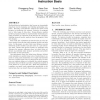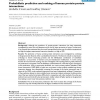393 search results - page 28 / 79 » Identifying Most Predictive Items |
ICIA
2007
13 years 9 months ago
2007
Tasks have been identified as playing an important role to knowledge workers as high-level units for organizing their information. TaskTracer is a task-aware desktop system that l...
BMCBI
2008
13 years 7 months ago
2008
Background: Most methods available to predict protein epitopes are sequence based. There is a need for methods using 3D information for prediction of discontinuous epitopes and de...
JCST
2008
13 years 7 months ago
2008
This paper presents some new algorithms to efficiently mine max frequent generalized itemsets (g-itemsets) and essential generalized association rules (g-rules). These are compact ...
ACMMSP
2004
ACM
14 years 29 days ago
2004
ACM
Feedback-directed optimization has become an increasingly important tool in designing and building optimizing compilers. Recently, reuse-distance analysis has shown much promise i...
BMCBI
2007
13 years 7 months ago
2007
Background: Although the prediction of protein-protein interactions has been extensively investigated for yeast, few such datasets exist for the far larger proteome in human. Furt...


